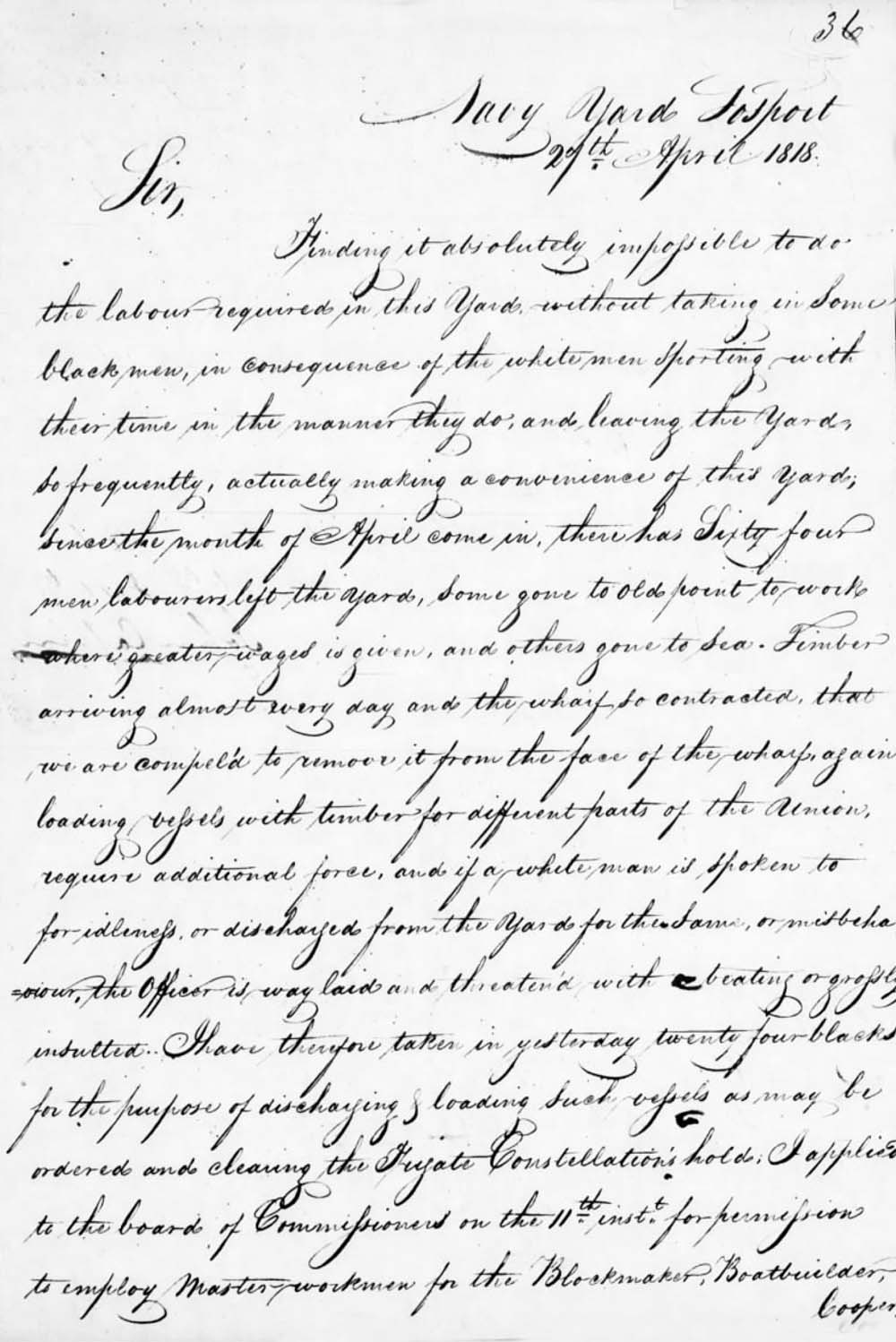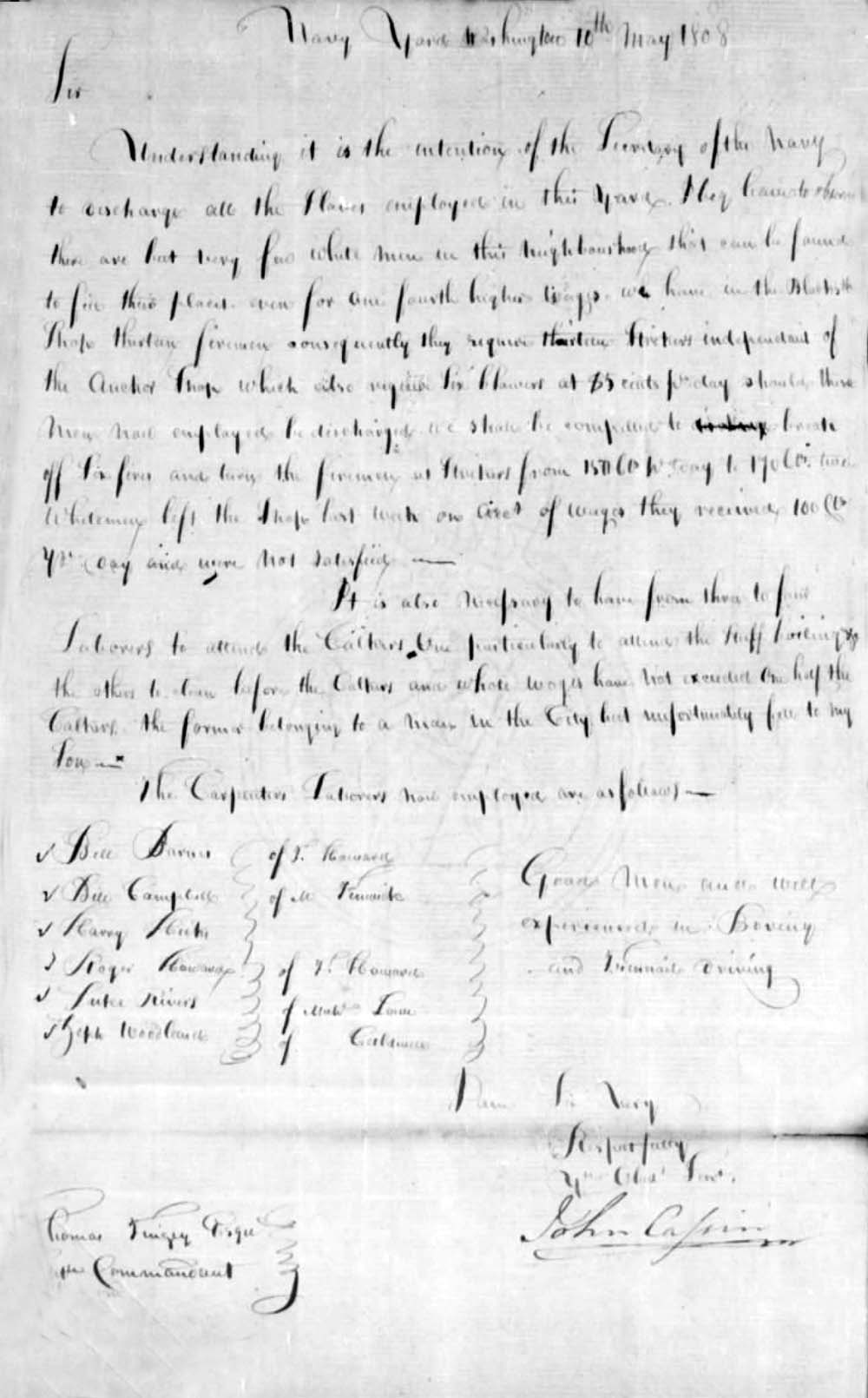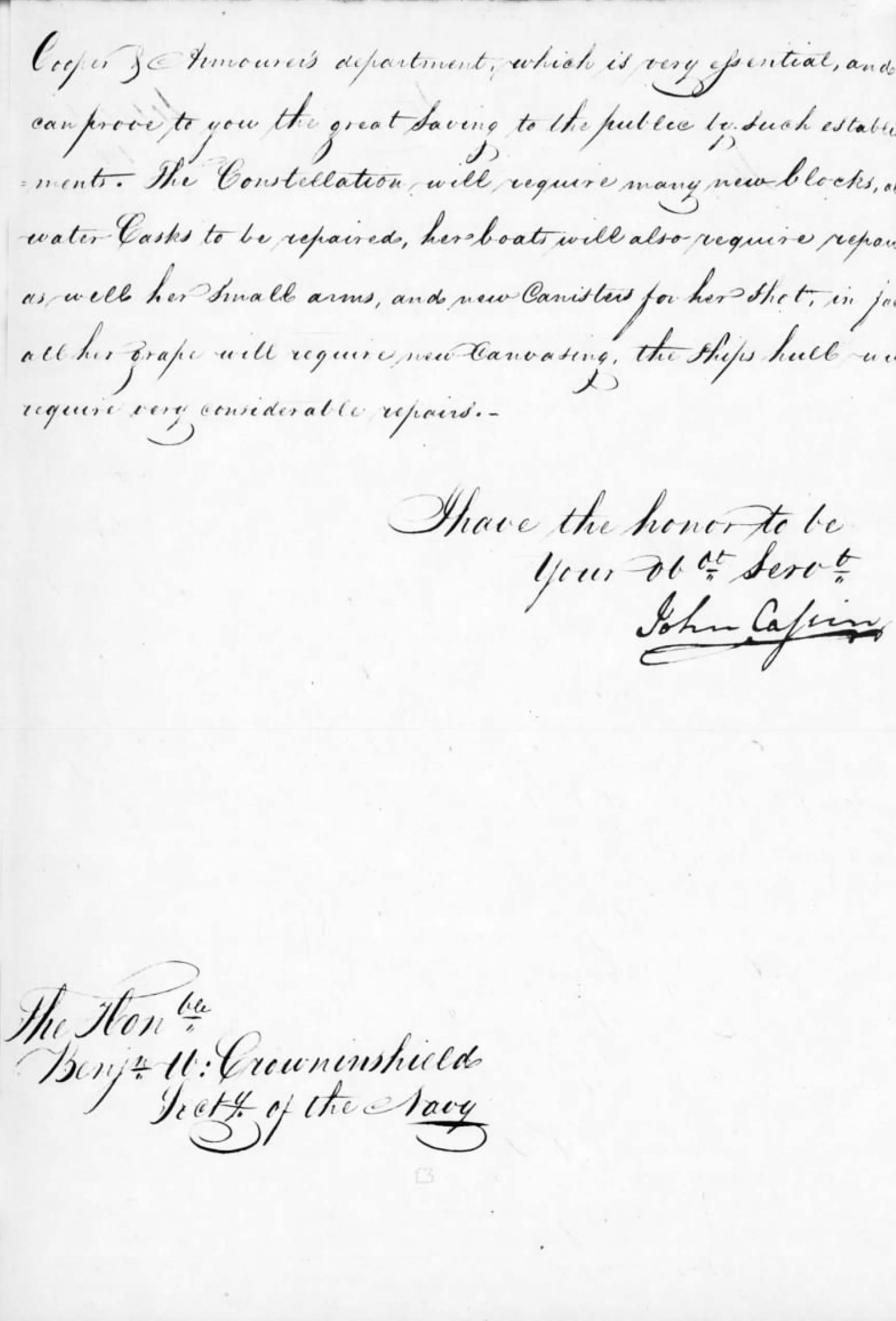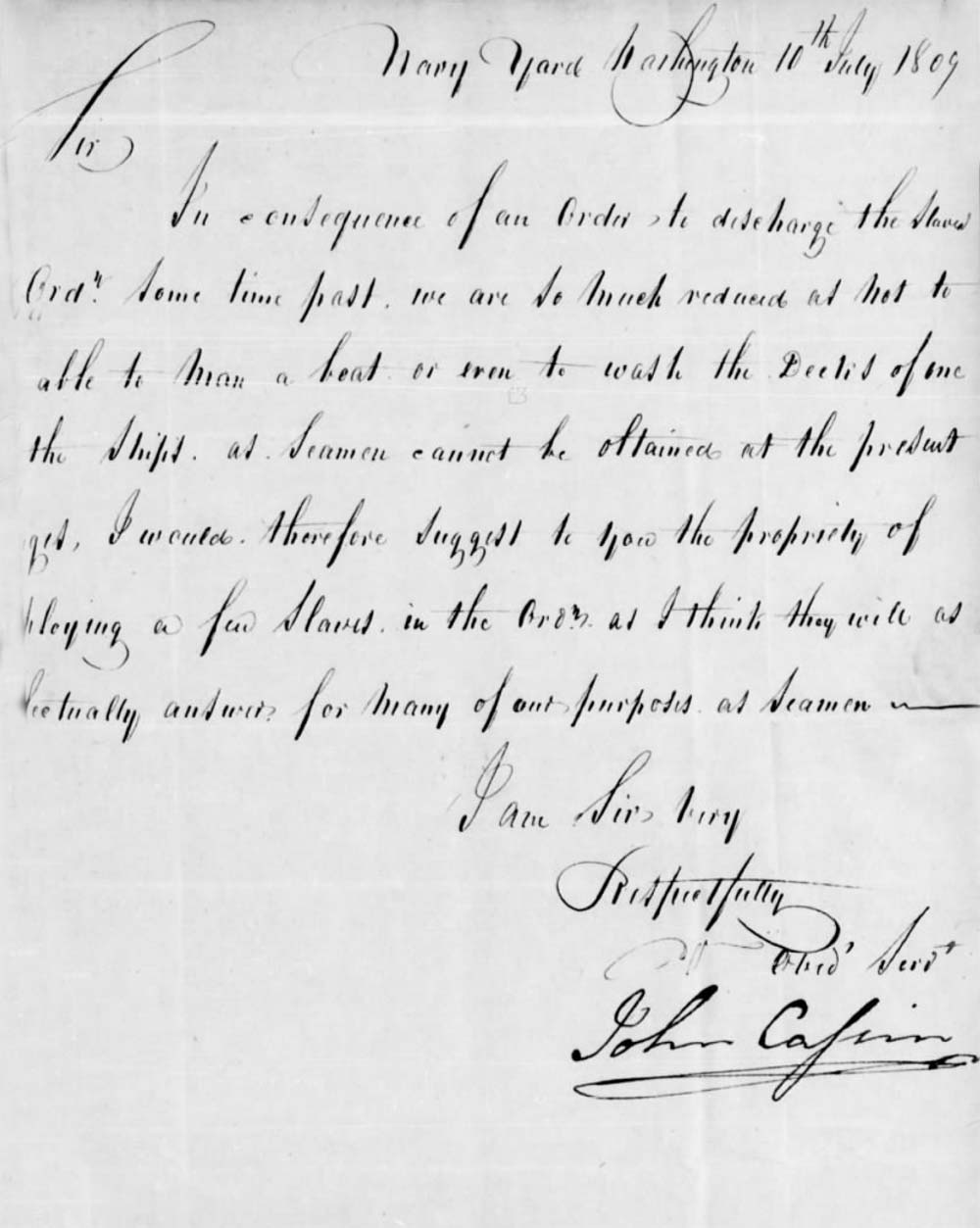End Notes
1 John G. Sharp Norfolk Navy Yard Special Topics “COMMODORE JOHN CASSIN 1760 – 1822”
http://www.usgwarchives.net/va/portsmouth/shipyard/nnysharp3.html accessed 2 March 20192 Gordon S. Brown The Captain Who Burned His Ships Captain Thomas Tingey, USN 1750 -1829 (Naval Institute Press Annapolis 2011),148 and BNC Circular 17 March 1817, NARA, RG45/E307, Vol.1
3 John Cassin to Benjamin W. Crowninshield NARA “Captains Letters” 1805 -1885 1 April 1818 – 30 June 1818 dated 27 April 1818, letter 36, 1-2
Benjamin Williams Crowninshield (1772 – 1851) Secretary of the Navy between 1815 and 1818, during the administrations of Presidents James Madison and James Monroe
4 Thomas Tingey to Robert Smith 16 May 1806 NARA M125 “Captains Letters” 1805,-1885 1 Jan 1806 -21 May 1806 letter number 97 re Detailed list of wage reductions by trade wage, reductions averaged 17% Thomas Tingey to the BNC dated 9 January 1821 re “Statement of wages given to Mechanics &c in Navy Yard Washington from 1801 to1820 “5 For “useful check” of enslaved labor on white employees see Thomas Johnson, David Stuart, and Daniel Carroll, Commissioners to Thomas Jefferson Jan. 5, 1793 District of Columbia Commissioners Letter book Vol. I, 1791--1793, NARA RG 351 and the effect of the practice on WNY see Linda M. Maloney, The Captain from Connecticut: The Life and Naval Times of Isaac Hull (Boston: Northeastern University Press, 1986), 421-422 and Bob Arnebeck, Through a Fiery Trial Building Washington 1790-1800 (New York: Madison Books:, 1991), 597-598.
6 Warrington to the Board of Navy Commissioners 12 October 1831NARA RG 45, Section 314.
7 George Teamoh God Made Man Man Made the Slave: The Autobiography of George Teamoh, edited by F.N. Boney, Richard L. Hume and Rafia Zafar (Macon: Mercer University Press, 1990), 84 - 85
8 District of Columbia, Deed Book, Liber No 30 p.212 Benjamin King to John Davis of Able, and John Cassin, re Bill of Sale for George Plowden and Jim Smith 2 April 1813 Benjamin King a WNY blacksmith stated in consideration of John Davis of Able and John Cassin his two black men George Plowden and Jim Smith, would serve as security to hold as Cassin and Davis property in case he King did not pay the debts as specified on or before 23 August 1813.
9 For the first thirty years of the nineteen century, the navy yard was the Districts principal employer of enslaved African Americans. Their numbers rose rapidly and by 1808, muster lists reflect they made up one third of the workforce. Diary of Michael Shiner Relating to the History of the Washington Navy Yard 1813 -1869 Naval History and Heritage Command 2015 transcribed and edited by John G. Sharp
https://www.history.navy.mil/research/library/online-reading-room/title-list-alphabetically/d/diary-of-michael-shiner/introduction.html
Accessed 1 March 201910 Cassin to Robert Smith 10 May 1808 NARA “Captains Letters” 1805 -1885 1 April 1808 – 28 June 1808, letter number, 68
11 Cassin to Paul Hamilton, 10 July 1809 NARA “Captains Letters” 1805 -1885 1 July 1809 – 10 Sept 1809, letter number 19. See also Gordon S. Brown The Captain Who Burned His Ships Captain Thomas Tingey, USN 1750 -1829 (Naval Institute Press Annapolis 2011), 76
12 Lewis Warrington to James K. Paulding 21 June 1839 “I beg leave to state, that no Slave employed in this Yard, is owned by a commissioned officer, but that many are owed by the Master Mechanicks & workmen of the Yard - … The numbers of black labourers in the neighborhood, & the demand for them this year, makes it an object of importance as many [will] hire them for employment here” Warrington to the Secretary of the Navy NARA, 21 June 1839 “Captains Letters” 1 June 1839 -30 June 1839 , letter number 77
13 Robert S. Starobin, Industrial Slavery in the Old South, (Oxford University press: New York third edition 1972), 32
14 “The naming of Old Point Comfort is thus told by Percy, (as quoted by Charles Deane in his edition of Captain John Smith's True Relation of Virginia :) On the 28th of April, launching their shallop, "the captain and some gentlemen went in her and discovered up the bay," and "found a riuer on the south side running into the maine." After exploring for some time, they rowed back to their ships, "which road at the mouth of the riuer." They found the waters shallow; but, pulling over to a point of land where they found from six to twelve fathoms, they were "put in good comfort," and named the place Point Comfort, or Cape Comfort.” Edward P. Lull History of the United States Navy-Yard at Gosport, Virginia, (Government Printing Office: Washington 1871), np
http://www.usgwarchives.net/va/portsmouth/shipyard/nnybooks1.html
accessed 2 March 2019


1& 2. April 27, 1818, enddnote #3
3. May 10, 1808, endnote #10
4. July 10, 1809, endnote #11John G. “Jack” Sharp resides in Concord, California. He worked for the United States Navy for thirty years as a civilian personnel officer. Among his many assignments were positions in Berlin, Germany, where in 1989 he was in East Berlin, the day the infamous wall was opened. He later served as Human Resources Officer, South West Asia (Bahrain). He returned to the United States in 2001 and was on duty at the Naval District of Washington on 9/11. He has a lifelong interest in history and has written extensively on the Washington, Norfolk, and Pensacola Navy Yards, labor history and the history of African Americans. His previous books include African Americans in Slavery and Freedom on the Washington Navy Yard 1799 -1865, Morgan Hannah Press 2011. History of the Washington Navy Yard Civilian Workforce 1799-1962, 2004.
https://www.history.navy.mil/content/dam/nhhc/browse-by-topic/heritage/washington-navy-yard/pdfs/WNY_History.pdf
and the first complete transcription of the Diary of Michael Shiner Relating to the History of the Washington Navy Yard 1813-1869, 2007/2015 online:
https://www.history.navy.mil/research/library/online-reading-room/title-list-alphabetically/d/diary-of-michael-shiner.html
His most recent work includes Register of Patients at Naval Hospital Washington DC 1814 With The Names of American Wounded From The Battle of Bladensburg 2018,
https://www.history.navy.mil/research/library/online-reading-room/title-list-alphabetically/r/register-patients-naval-hospital-washington-dc-1814.html
The last three works were all published by the Naval History and Heritage Command. John served on active duty in the United States Navy, including Viet Nam service. He received his BA and MA in History from San Francisco State University. He can be reached at sharpjg@yahoo.com

